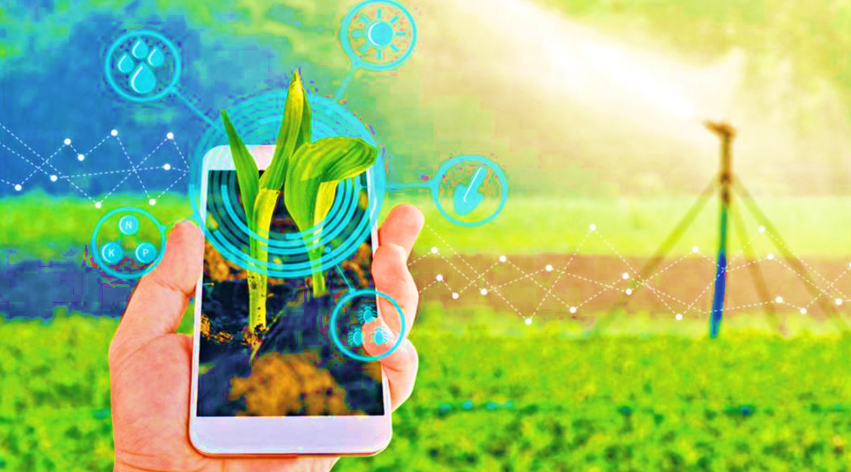Digital Agriculture Mission (GS Paper 2, Government Policies)

Context
- The Union Cabinet has recently approved the Digital Agriculture Mission (DAM) with a substantial outlay of ₹2,817 crore, including a central share of ₹1,940 crore.
- This initiative aims to revolutionize the agricultural sector through advanced digital technologies and infrastructure.
About the Digital Agriculture Mission
The Digital Agriculture Mission seeks to enhance Indian agriculture by leveraging the latest advancements in:
- Cloud Computing
- Earth Observation
- Remote Sensing
- Data Analytics
- Artificial Intelligence (AI) and Machine Learning (ML)
Conceived as an umbrella scheme, DAM will support various digital agriculture initiatives, including the creation of Digital Public Infrastructure (DPI), the implementation of the Digital General Crop Estimation Survey (DGCES), and other IT-driven projects by Central and State Governments, as well as academic and research institutions.
Mission’s Roots
At its core, DAM aims to digitize and modernize agriculture by providing:
- Digital Identity for Farmers: Similar to Aadhaar, each farmer will receive a unique 'Kisan ki Pehchaan' (Farmer ID), linking them to central and state government databases.
- Data-Driven Services: A comprehensive and integrated data platform to provide services tailored to individual farmers' needs.
Three Pillars of the Digital Agriculture Mission
Agristack
- Purpose: A digital ecosystem for farmers.
- Components:
- Farmers’ Registry: A digital directory of farmers.
- Geo-referenced Village Maps: Maps detailing crops and other agricultural data for each village.
- Crop Sown Registry: A digital ledger documenting crop planting information.
Krishi Decision Support System
- Objective: To offer reliable, real-time information to farmers for better decision-making.
- Features:
- Geospatial Data Integration: Aggregates data on crops, soil, weather, water resources, etc.
- Soil Profile Mapping: Provides detailed information on soil properties, moisture, and nutrients.
Soil Profile Mapping
- Goal: To enable precision agriculture through accurate soil data.
Complementary Schemes to Enhance Farmer Welfare
Crop Science for Food and Nutritional Security
- Outlay: ₹3,979 crore
- Focus Areas: Research and education, plant genetic resources, crop improvement, and research on pests and diseases.
Strengthening Agricultural Education, Management, and Social Sciences
- Outlay: ₹2,291 crore
- Components: Modernizing research and education, aligning with the New Education Policy 2020, and incorporating advanced technologies like AI and big data.
Sustainable Livestock Health and Production
- Outlay: ₹1,702 crore
- Focus Areas: Animal health management, veterinary education, dairy technology, and genetic improvement.
Sustainable Development of Horticulture
- Outlay: ₹1,129.30 crore
- Components: Development across various horticultural crops, including vegetables, fruits, spices, and medicinal plants.
Strengthening of Krishi Vigyan Kendra
- Outlay: ₹1,202 crore
- Objective: To enhance agricultural extension services and resource management.
Natural Resource Management
- Outlay: ₹1,115 crore
- Goal: To promote sustainable use of natural resources.
Significances of the Digital Agriculture Mission
Efficient Services:
- Faster Access: Provides quicker access to agricultural services and schemes, similar to timely monsoon rains.
- Data-Driven Decisions: AI and data analytics offer precise crop predictions and personalized recommendations.
Inclusive Growth and Employment:
- Employment Opportunities: Expected to create around 2.5 lakh jobs for trained local youth and Krishi Sakhis.
Resilience:
- Early Alerts: Provides timely warnings about pests, diseases, and droughts, enhancing farmers' resilience to challenges.
Conclusion
- The Digital Agriculture Mission is poised to reshape India’s agricultural landscape by integrating advanced technology with traditional farming practices.
- With a focus on data-driven services and digital infrastructure, DAM aims to boost productivity, enhance farmer incomes, and contribute to the broader vision of a developed India by 2047 (Viksit Bharat@2047).
- The mission represents a significant step towards a more modern, efficient, and inclusive agricultural sector.


